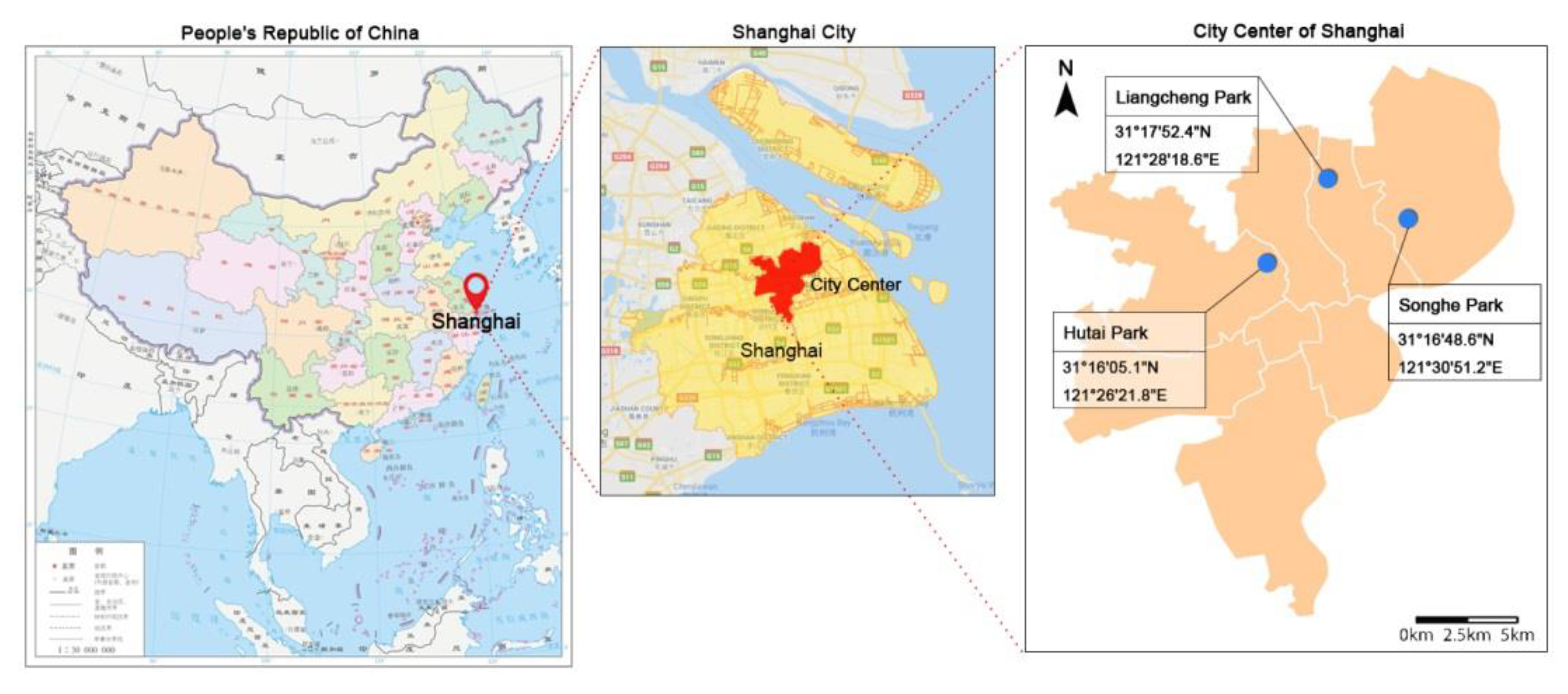An Observational Study of Park Attributes and Physical Activity in Neighborhood Parks of Shanghai, China
Abstract
1. Introduction
2. Materials and Methods
2.1. Study Sites
2.2. Behavior Settings in the Parks
2.3. Data Collection
2.4. Data Analysis
3. Results
3.1. Overall Physical Activity Levels in Neighborhood Parks
3.2. Physical Activity Levels by Setting Types
3.3. Physical Activity Levels by Setting Attributes
3.4. Other Affecting Factors for Levels of Physical Activity
3.4.1. Times of the Day
3.4.2. Age and Gender Differences
4. Discussions
4.1. Setting Types and Physical Activity Level
4.2. Cultural Differences in Park Use
4.3. Strengths and Limitations
5. Conclusions
Author Contributions
Funding
Acknowledgments
Conflicts of Interest
Appendix A
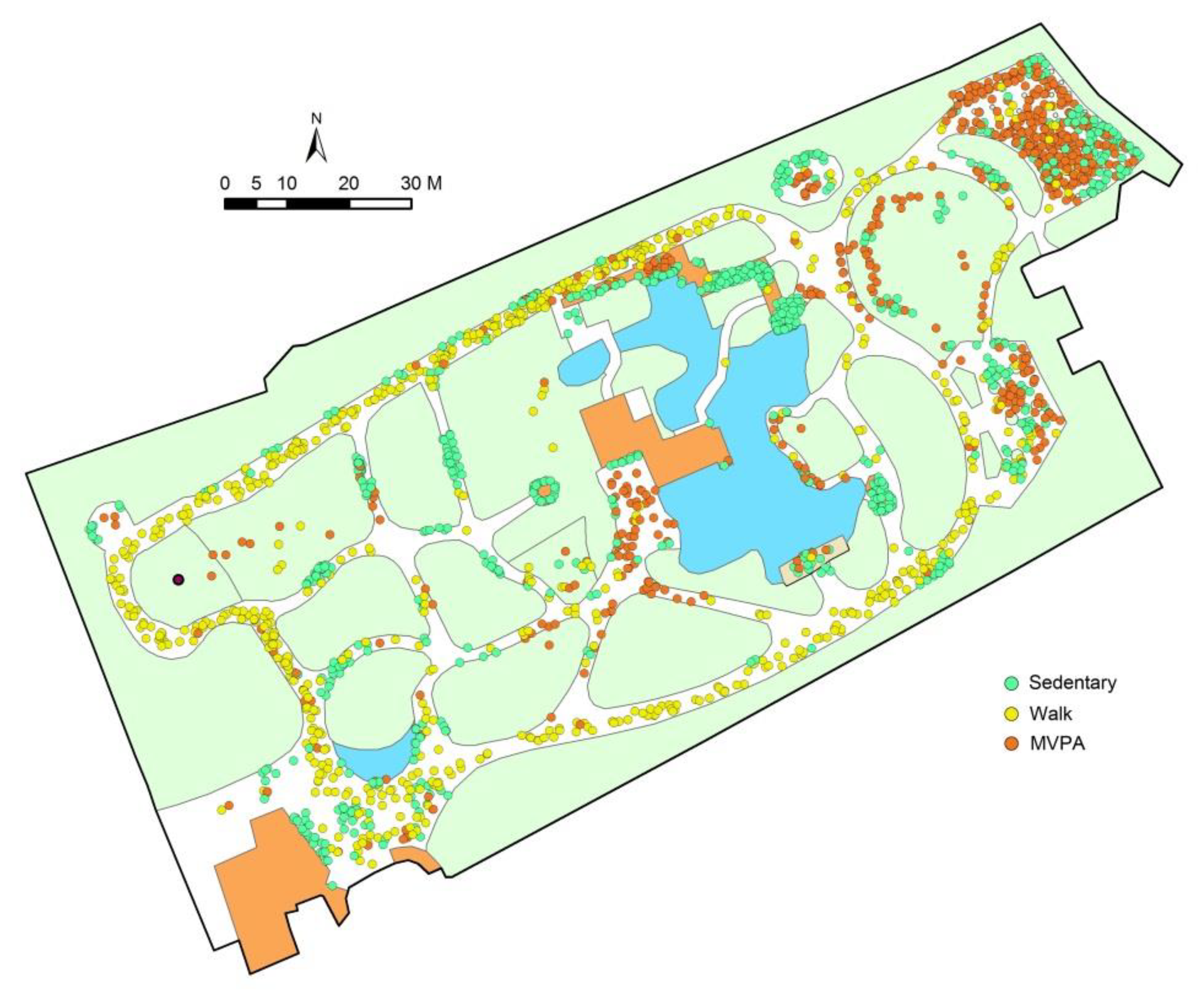

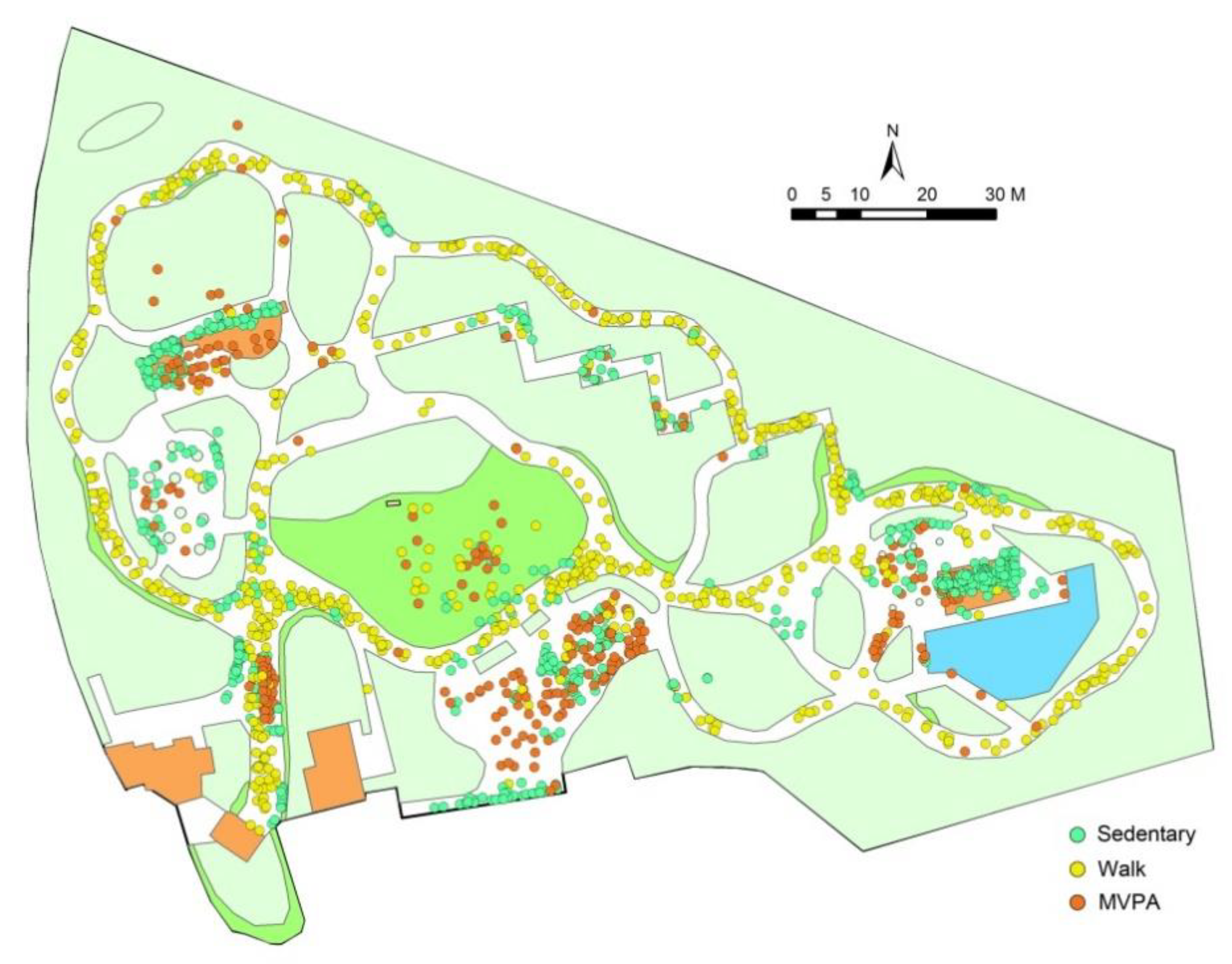
References
- Churilla, J.R.; Zoeller, R.F. Physical activity: Physical activity and the metabolic syndrome: A review of the evidence. Am. J. Lifestyle Med. 2008, 2, 118–125. [Google Scholar] [CrossRef]
- Hallal, P.C.; Victora, C.G.; Azevedo, M.R.; Wells, J.C. Adolescent physical activity and health: A systematic review. Sports Med. 2006, 36, 1019–1030. [Google Scholar] [CrossRef]
- Warburton, D.E.R.; Nicol, C.W.; Bredin, S.S.D. Health benefits of physical activity: The evidence. Can. Med Assoc. J. 2006, 174, 801–809. [Google Scholar] [CrossRef]
- Carlson, S.A.; Adams, E.K.; Yang, Z.; Fulton, J.E. Percentage of deaths associated with inadequate physical activity in the United States. Prev. Chronic Dis. 2018, 15, E38. [Google Scholar] [CrossRef]
- Centre for Economics and Business Research. The Economic Cost of Physical Inactivity in Europe. Available online: https://inactivity-time-bomb.nowwemove.com/report/ (accessed on 14 February 2020).
- Ng, S.W.; Popkin, B.M. Time use and physical activity: A shift away from movement across the globe. Obes. Rev. 2012, 13, 659–680. [Google Scholar] [CrossRef]
- Muntner, P.; Gu, D.; Wildman, R.P.; Chen, J.; Qan, W.; Whelton, P.K.; He, J. Prevalence of physical activity among Chinese adults: Results from the international collaborative study of cardiovascular disease in Asia. Am. J. Public Health 2005, 95, 1631–1636. [Google Scholar] [CrossRef]
- Zhang, J.; Chaaban, J. The economic cost of physical inactivity in China. Prev. Med. 2013, 56, 75–78. [Google Scholar] [CrossRef]
- Wu, S.; Luo, Y.; Qiu, X.; Bao, M. Building a healthy China by enhancing physical activity: Priorities, challenges, and strategies. J. Sport Health Sci. 2017, 6, 125–126. [Google Scholar] [CrossRef][Green Version]
- Lee, C.; Moudon, A.V. Neighbourhood design and physical activity. Build. Res. Inf. 2008, 36, 395–411. [Google Scholar] [CrossRef]
- Saelens, B.E.; Handy, S.L. Built environment correlates of walking: A review. Med. Sci. Sports Exerc. 2008, 40, S550–S566. [Google Scholar] [CrossRef]
- Coombes, E.; Jones, A.P.; Hillsdon, M. The relationship of physical activity and overweight to objectively measured green space accessibility and use. Soc. Sci. Med. 2010, 70, 816–822. [Google Scholar] [CrossRef] [PubMed]
- Koohsari, M.J.; Karakiewicz, J.A.; Kaczynski, A.T. Public open space and walking: The role of proximity, perceptual qualities of the surrounding built environment, and street configuration. Environ. Behav. 2012, 45, 706–736. [Google Scholar] [CrossRef]
- Lachowycz, K.; Jones, A.P. Greenspace and obesity: A systematic review of the evidence. Obes. Rev. 2011, 12, e183–e189. [Google Scholar] [CrossRef]
- Shin, W.-H.; Kweon, B.-S.; Shin, W.-J. The distance effects of environmental variables on older African American women’s physical activity in Texas. Landsc. Urban Plan. 2011, 103, 217–229. [Google Scholar] [CrossRef]
- Rogerson, M.; Gladwell, V.F.; Gallagher, D.J.; Barton, J.L. Influences of green outdoors versus indoors environmental settings on psychological and social outcomes of controlled exercise. Int. J. Environ. Res. Public Health 2016, 13, 363. [Google Scholar] [CrossRef] [PubMed]
- Hartig, T.; Mitchell, R.; de Vries, S.; Frumkin, H. Nature and health. Annu. Rev. Public Health 2014, 35, 207–228. [Google Scholar] [CrossRef] [PubMed]
- Kemperman, A.; Timmermans, H. Green spaces in the direct living environment and social contacts of the aging population. Landsc. Urban Plan. 2014, 129, 44–54. [Google Scholar] [CrossRef]
- Cohen, D.A.; Kristin, J.L. How Can Neighborhood Parks Be Used to Increase Physical Activity? RAND Corporation: Santa Monica, CA, USA, 2018; Available online: https://www.rand.org/pubs/research_reports/RR2490.html (accessed on 3 January 2020).
- Berman, M.G.; Jonides, J.; Kaplan, S. The cognitive benefits of interacting with nature. Psychol. Sci. 2008, 19, 1207–1212. [Google Scholar] [CrossRef]
- Cohen, D.A.; Han, B.; Nagel, C.J.; Harnik, P.; McKenzie, T.L.; Evenson, K.R.; Marsh, T.; Williamson, S.; Vaughan, C.; Katta, S. The first national study of neighborhood parks: Implications for physical activity. Am. J. Prev. Med. 2016, 51, 419–426. [Google Scholar] [CrossRef]
- Mennis, J.; Mason, M.; Ambrus, A. Urban greenspace is associated with reduced psychological stress among adolescents: A Geographic Ecological Momentary Assessment (GEMA) analysis of activity space. Landsc. Urban Plan. 2018, 174, 1–9. [Google Scholar] [CrossRef]
- Sugiyama, T.; Carver, A.; Koohsari, M.J.; Veitch, J. Advantages of public green spaces in enhancing population health. Landsc. Urban Plan. 2018, 178, 12–17. [Google Scholar] [CrossRef]
- Tinsley, H.E.A.; Tinsley, D.J.; Croskeys, C.E. Park usage, social milieu, and psychosocial benefits of park use reported by older urban park users from four ethnic groups. Leis. Sci. 2002, 24, 199–218. [Google Scholar] [CrossRef]
- Veitch, J.; Salmon, J.; Parker, K.; Bangay, S.; Deforche, B.; Timperio, A. Adolescents’ ratings of features of parks that encourage park visitation and physical activity. Int. J. Behav. Nutr. Phys. Act. 2016, 13, 73. [Google Scholar] [CrossRef] [PubMed]
- Kowaleski-Jones, L.; Fan, J.X.; Wen, M.; Hanson, H. Neighborhood context and youth physical activity: Differential associations by gender and age. Am. J. Health Promot. 2017, 31, 426–434. [Google Scholar] [CrossRef] [PubMed]
- Zhang, W.; Yang, J.; Ma, L.; Huang, C. Factors affecting the use of urban green spaces for physical activities: Views of young urban residents in Beijing. Urban For. Urban Green. 2015, 14, 851–857. [Google Scholar] [CrossRef]
- Baran, P.K.; Smith, W.R.; Moore, R.C.; Floyd, M.F.; Bocarro, J.N.; Cosco, N.G.; Danninger, T.M. Park use among youth and adults: Examination of individual, social, and urban form factors. Environ. Behav. 2014, 46, 768–800. [Google Scholar] [CrossRef]
- Koohsari, M.J.; Mavoa, S.; Villanueva, K.; Sugiyama, T.; Badland, H.; Kaczynski, A.T.; Owen, N.; Giles-Corti, B. Public open space, physical activity, urban design and public health: Concepts, methods and research agenda. Health Place 2015, 33, 75–82. [Google Scholar] [CrossRef]
- Park, K. Park and neighborhood attributes associated with park use: An observational study using unmanned aerial vehicles. Environ. Behav. 2019. [Google Scholar] [CrossRef]
- Costigan, S.A.; Veitch, J.; Crawford, D.; Carver, A.; Timperio, A. A Cross-sectional investigation of the importance of park features for promoting regular physical activity in parks. Int. J. Environ. Res. Public Health 2017, 14, 1335. [Google Scholar] [CrossRef]
- Kaczynski, A.T.; Potwarka, L.R.; Saelens, B.E. Association of park size, distance, and features with physical activity in neighborhood parks. Am. J. Public Health 2008, 98, 1451–1456. [Google Scholar] [CrossRef]
- Van Hecke, L.; Ghekiere, A.; Veitch, J.; Van Dyck, D.; Van Cauwenberg, J.; Clarys, P.; Deforche, B. Public open space characteristics influencing adolescents’ use and physical activity: A systematic literature review of qualitative and quantitative studies. Health Place 2018, 51, 158–173. [Google Scholar] [CrossRef] [PubMed]
- Zacharias, J.; Stathopoulos, T.; Wu, H. Spatial behavior in San Francisco’s plazas: The effects of microclimate, other people, and environmental design. Environ. Behav. 2004, 36, 638–658. [Google Scholar] [CrossRef]
- McCormack, G.R.; Rock, M.; Toohey, A.M.; Hignell, D. Characteristics of urban parks associated with park use and physical activity: A review of qualitative research. Health Place 2010, 16, 712–726. [Google Scholar] [CrossRef] [PubMed]
- Peschardt, K.K.; Stigsdotter, U.K. Associations between park characteristics and perceived restorativeness of small public urban green spaces. Landsc. Urban Plan. 2013, 112, 26–39. [Google Scholar] [CrossRef]
- Veitch, J.; Salmon, J.; Deforche, B.; Ghekiere, A.; Van Cauwenberg, J.; Bangay, S.; Timperio, A. Park attributes that encourage park visitation among adolescents: A conjoint analysis. Landsc. Urban Plan. 2017, 161, 52–58. [Google Scholar] [CrossRef]
- Hill, M.R. Stalking the urban pedestrian: A comparison of questionnaire and tracking methodologies for behavioral mapping in large-scale environments. Environ. Behav. 1984, 16, 539–550. [Google Scholar] [CrossRef]
- Cosco, N.G.; Moore, R.C.; Islam, M.Z. Behavior mapping: A method for linking preschool physical activity and outdoor design. Med. Sci. Sports Exerc. 2010, 42, 513–519. [Google Scholar] [CrossRef]
- McKenzie, T.L.; Marshall, S.J.; Sallis, J.F.; Conway, T.L. Leisure-time physical activity in school environments: An observational study using SOPLAY. Prev. Med. 2000, 30, 70–77. [Google Scholar] [CrossRef]
- Blennerhassett, J.M.; Borschmann, K.N.; Lipson-Smith, R.A.; Bernhardt, J. Behavioral mapping of patient activity to explore the built environment during rehabilitation. HERD Health Environ. Res. Des. J. 2018, 11, 109–123. [Google Scholar] [CrossRef]
- Hamilton, K.; Kaczynski, A.T.; Fair, M.L.; Lévesque, L. Examining the relationship between park neighborhoods, features, cleanliness, and condition with observed weekday park usage and physical activity: A case study. J. Environ. Public Health 2017. [Google Scholar] [CrossRef]
- McKenzie, T.L.; Cohen, D.A.; Sehgal, A.; Williamson, S.; Golinelli, D. System for Observing Play and Recreation in Communities (SOPARC): Reliability and feasibility measures. J. Phys. Act. Health 2006, 3, S208–S222. [Google Scholar] [CrossRef] [PubMed]
- Evenson, K.R.; Jones, S.A.; Holliday, K.M.; Cohen, D.A.; McKenzie, T.L. Park characteristics, use, and physical activity: A review of studies using SOPARC (System for Observing Play and Recreation in Communities). Prev. Med. 2016, 86, 153–166. [Google Scholar] [CrossRef]
- Goličnik, B.; Ward Thompson, C. Emerging relationships between design and use of urban park spaces. Landsc. Urban Plan. 2010, 94, 38–53. [Google Scholar] [CrossRef]
- Evenson, K.R.; Williamson, S.; Han, B.; McKenzie, T.L.; Cohen, D.A. United States’ neighborhood park use and physical activity over two years: The national study of neighborhood parks. Prev. Med. 2019, 123, 117–122. [Google Scholar] [CrossRef] [PubMed]
- Gibson, J.J. The Ecological Approach to Visual Perception; Houghton Mifflin: Boston, MA, USA, 1979. [Google Scholar]
- Barker, R.G. Ecological Psychology: Concepts and Methods for Studying the Environment of Human Behavior; Stanford University Press: Stanford, CA, USA, 1968. [Google Scholar]
- Floyd, M.F.; Spengler, J.O.; Maddock, J.E.; Gobster, P.H.; Suau, L. Environmental and social correlates of physical activity in neighborhood parks: An observational study in Tampa and Chicago. Leis. Sci. 2008, 30, 360–375. [Google Scholar] [CrossRef]
- Xiao, Y.; Wang, D.; Fang, J. Exploring the disparities in park access through mobile phone data: Evidence from Shanghai, China. Landsc. Urban Plan. 2019, 181, 80–91. [Google Scholar] [CrossRef]
- Xiao, Y.; Wang, Z.; Li, Z.; Tang, Z. An assessment of urban park access in Shanghai—Implications for the social equity in urban China. Landsc. Urban Plan. 2017, 157, 383–393. [Google Scholar] [CrossRef]
- Nordh, H.; Hartig, T.; Hagerhall, C.M.; Fry, G. Components of small urban parks that predict the possibility for restoration. Urban For. Urban Green. 2009, 8, 225–235. [Google Scholar] [CrossRef]
- Wang, X.; Rodiek, S.; Wu, C.; Chen, Y.; Li, Y. Stress recovery and restorative effects of viewing different urban park scenes in Shanghai, China. Urban For. Urban Green. 2016, 15, 112–122. [Google Scholar] [CrossRef]
- Zhai, Y.; Baran, P.K.; Wu, C. Spatial distributions and use patterns of user groups in urban forest parks: An examination utilizing GPS tracker. Urban For. Urban Green. 2018, 35, 32–44. [Google Scholar] [CrossRef]
- Shanghai Landscaping & City Appearance Administrative Bureau. Shanghai Forestry Bureau. Available online: http://lhsr.sh.gov.cn/sites/ShanghaiGreen/dyn/ViewIndex.ashx (accessed on 30 January 2020).
- The State Council, The People’s Republic of China. Available online: http://www.gov.cn/xhtml/2016gov/images/guoqing/bigmap.jpg (accessed on 12 March 2020).
- Google Maps. Available online: http://maps.google.com (accessed on 12 March 2020).
- Cohen, D.A.; Setodji, C.; Evenson, K.R.; Ward, P.; Lapham, S.; Hillier, A.; McKenzie, T.L. How much observation is enough? Refining the administration of SOPARC. J. Phys. Act. Health 2011, 8, 1117–1123. [Google Scholar] [CrossRef] [PubMed]
- Abbott, M.L.; McKinney, J. Understanding and Applying Research Design; John Wiley & Sons, Inc.: Hoboken, NJ, USA, 2013. [Google Scholar]
- Rutledge, A.J. A Visual Approach to Park Design (Garland Series in Design); Garland STPM Press: New York, NY, USA, 1985. [Google Scholar]
- Arnold, C. Exercise bargain: Are walking loops worth the investment? Environ. Health Perspect. 2017, 125, A40. [Google Scholar] [CrossRef] [PubMed]
- Cohen, D.A.; Han, B.; Evenson, K.R.; Nagel, C.; McKenzie, T.L.; Marsh, T.; Williamson, S.; Harnik, P. The Prevalence and Use of Walking Loops in Neighborhood Parks: A National Study. Environ. Health Perspect. 2017, 125, 170–174. [Google Scholar] [CrossRef] [PubMed]
- Derose, K.P.; Han, B.; Williamson, S.; Cohen, D.A. Gender Disparities in Park Use and Physical Activity among Residents of High-Poverty Neighborhoods in Los Angeles. Women Health Issues 2018, 28, 6–13. [Google Scholar] [CrossRef]
- Park, K.; Ewing, R. The usability of unmanned aerial vehicles (UAVs) for measuring park-based physical activity. Landsc. Urban Plan. 2017, 167, 157–164. [Google Scholar] [CrossRef]
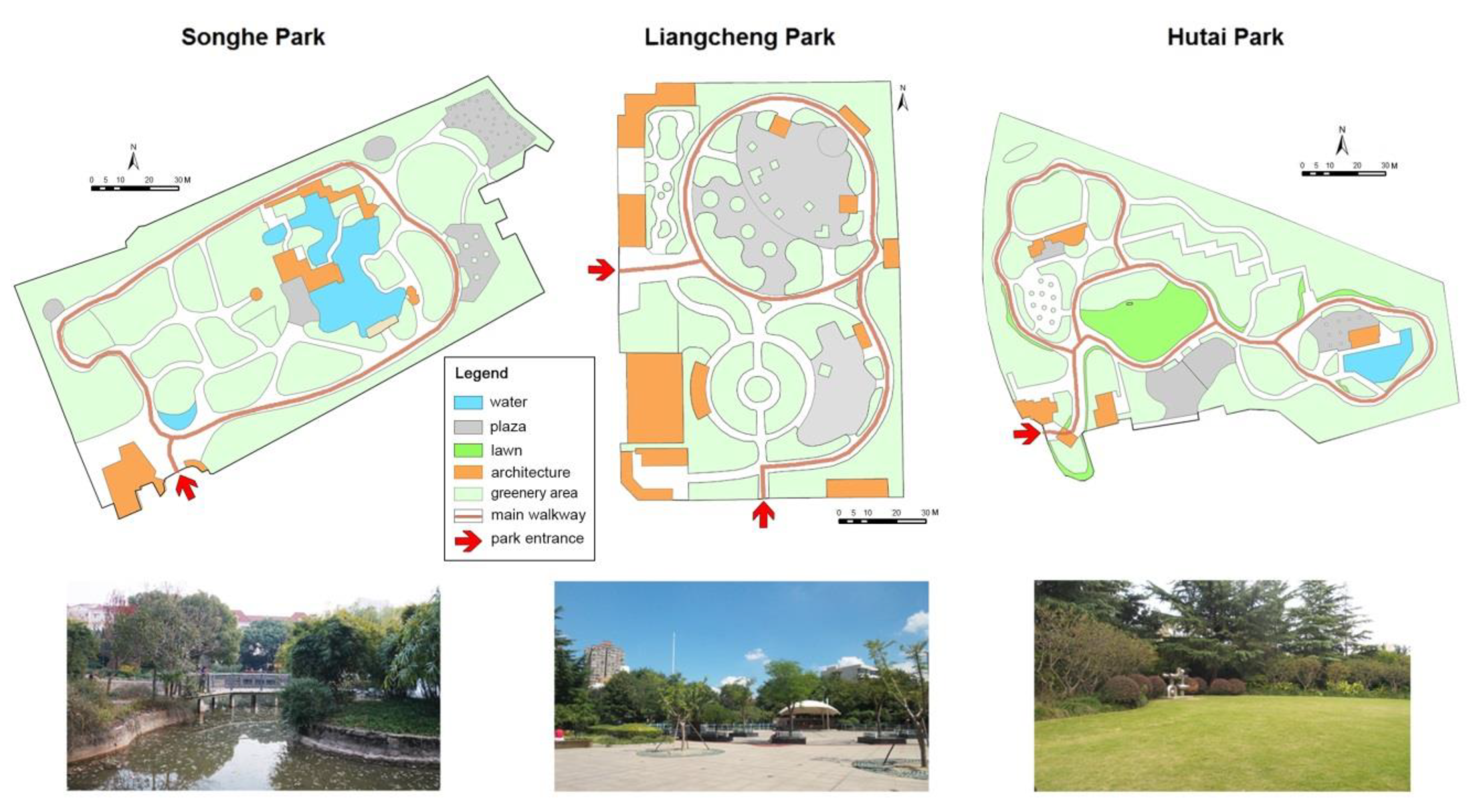
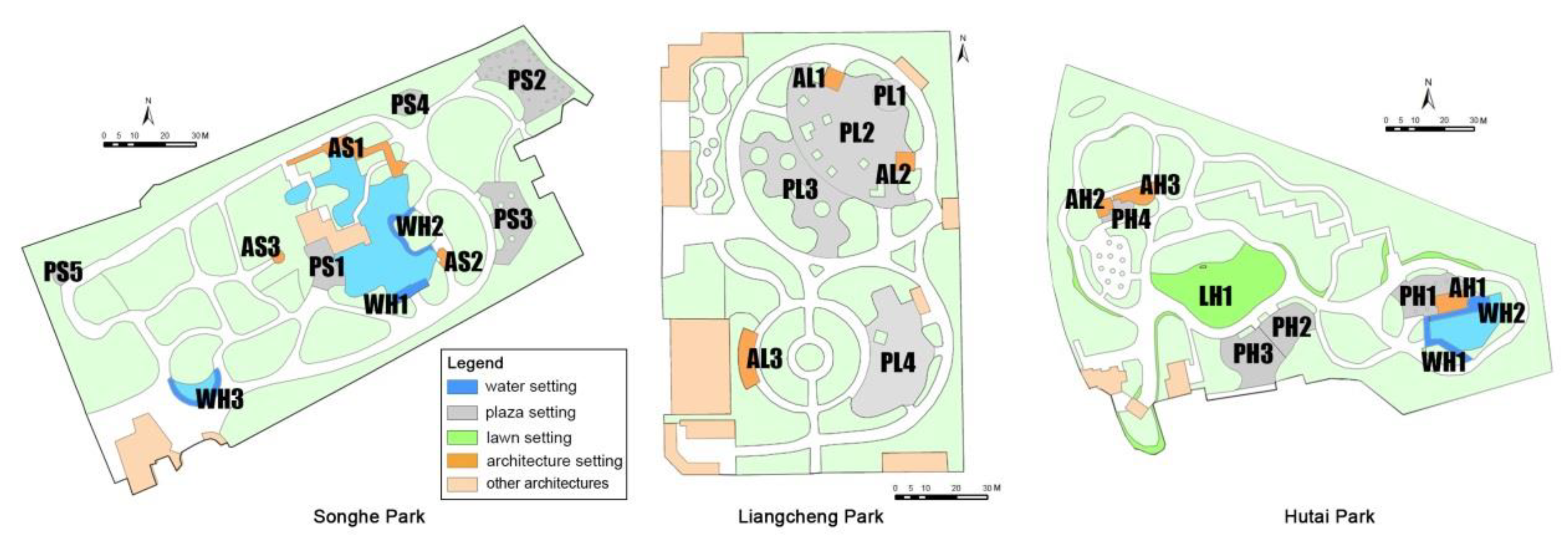
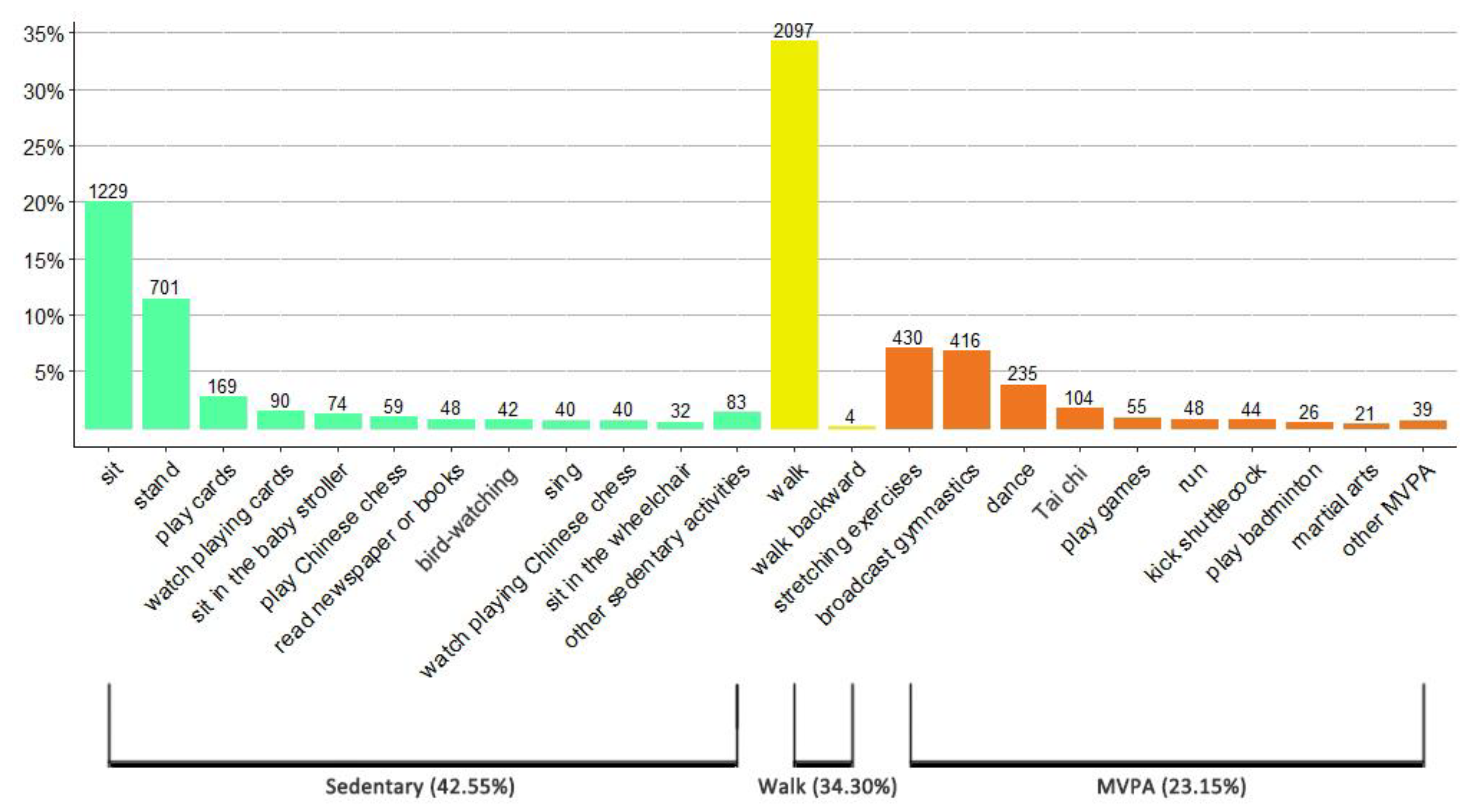



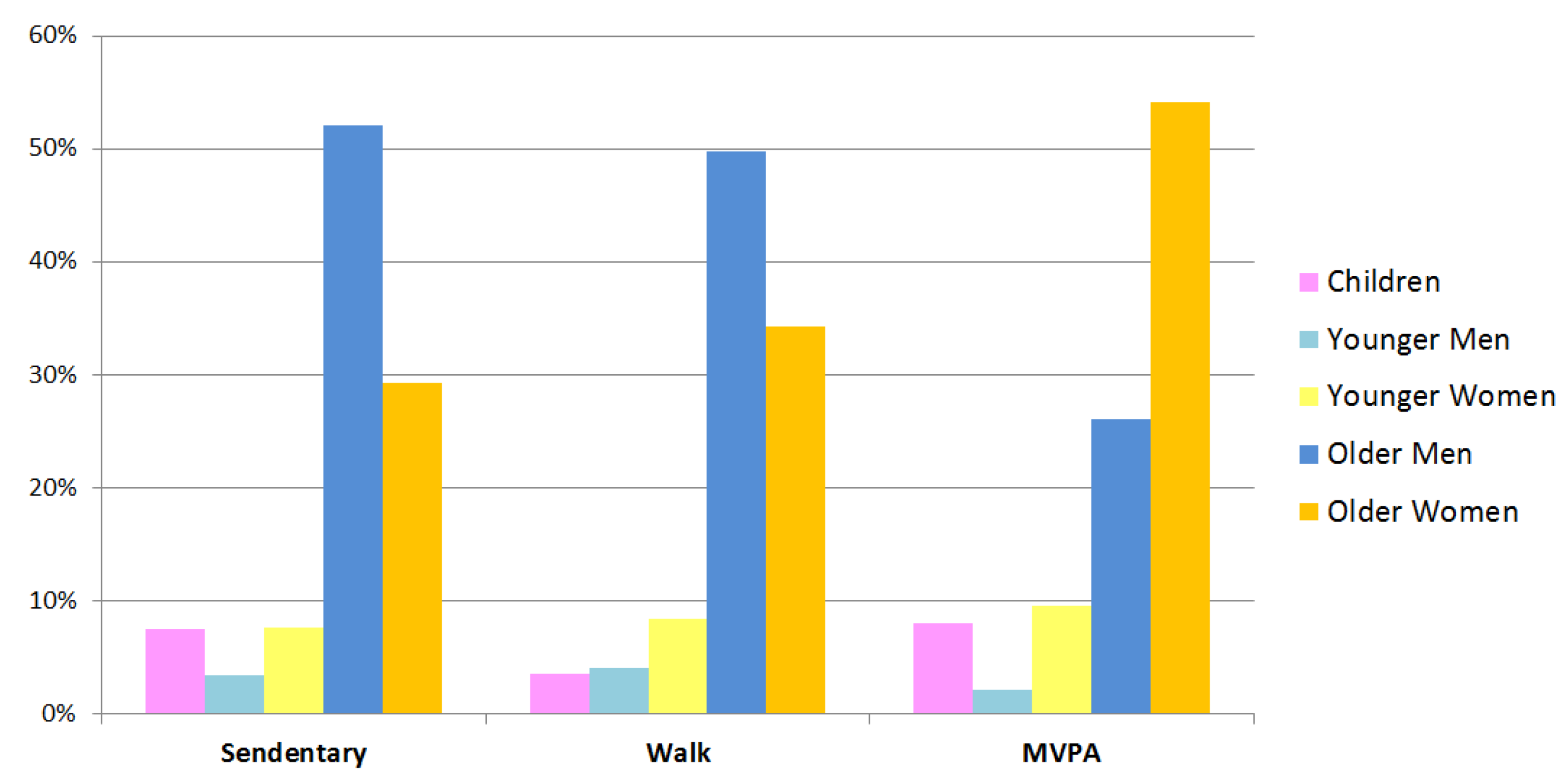
| Setting Type | Definition |
|---|---|
| Water | The accessible sites by the waterfront, where people’s activity is directly related to the water body. |
| Plaza | The hardscape feature in the park suitable for gathering and activity. |
| Lawn | The green space covered with grass, and people can step on it. |
| Architecture | The sites in landscape architectures, namely pavilions and pergolas, where people can enjoy an open view in an outdoor living space. |
| Setting Type | Number of Behavior Settings | ||
|---|---|---|---|
| Songhe Park | Liangcheng Park | Hutai Park | |
| Water | 3 (WS1–WS3) | 0 | 2 (WH1–WH2) |
| Plaza | 5 (PS1–PS5) | 4 (PL1–PL4) | 4 (PH1–PH4) |
| Lawn | 0 | 0 | 1 (LH1) |
| Architecture | 3 (AS1–AS3) | 3 (AL1–AL3) | 3 (AH1–AH3) |
| Plaza Code | Area (m2) | Size Category | Shade Trees | Exercise Equipment |
|---|---|---|---|---|
| PS1 | 132.78 | Medium | Plenty | No |
| PS2 | 400.53 | Medium | Plenty | Yes |
| PS3 | 271.72 | Medium | Scarce | Yes |
| PS4 | 71.88 | Small | Plenty | No |
| PS5 | 38.29 | Small | Plenty | No |
| PL1 | 88.69 | Small | Scarce | No |
| PL2 | 1237.50 | Large | Scarce | No |
| PL3 | 652.43 | Large | Plenty | No |
| PL4 | 729.59 | Large | Scarce | Yes |
| PH1 | 238.19 | Medium | Scarce | No |
| PH2 | 198.41 | Medium | Scarce | No |
| PH3 | 501.79 | Large | Scarce | No |
| PH4 | 45.62 | Small | Plenty | No |
| Activity Levels | Types of Physical Activity |
|---|---|
| Sedentary | sit (1229), stand (701), play cards (169), watch playing cards (90), sit in the baby stroller (74), play Chinese chess (59), read newspaper or books (48), bird-watching (42), sing (40), watch playing Chinese chess (40), sit in the wheelchair (32), take photos (16), use phones (14), eat food (12), listen to radio or music (9), lay on a bench (8), knit (8), embroider (7), play musical instruments (5), trim vegetables for cooking (4) |
| Walk | walk (2097), walk backward (4) |
| MVPA | stretching exercises (430), broadcast gymnastics (416), dance (235), Tai chi (104), play games (55), run (48), kick shuttlecock (44), play badminton (26), martial arts (21), roller skate (12), play Chinese swords (10), ride kids’ bikes (9), kick balls (4), play with water (3), fly kites (1) |
| Setting Type | Level of Physical Activity | ||
|---|---|---|---|
| Sedentary | Walk | MVPA | |
| Water | 45 (−0.7) | 11 (2.5) | 29 (−0.5) |
| Plaza | 882 (−18.6) | 136 (1.9) | 926 (18.1) |
| Lawn | 12 (−4.4) | 19 (9.6) | 16 (−0.4) |
| Architecture | 641 (21.2) | 12 (−5.9) | 51 (−18.8) |
| Plaza Size | Level of Physical Activity | |||
|---|---|---|---|---|
| Sedentary | Walk | MVPA | Total | |
| Small size (<100 m2) | ||||
| Count | 68 | 5 | 102 | 175 |
| Percentage within plaza size | 38.85% | 2.86% | 58.29% | 100% |
| Adjusted residuals | −1.8 | −2.3 | 3.0 | |
| Medium size (100–500 m2) | ||||
| Count | 275 | 70 | 428 | 773 |
| Percentage within plaza size | 35.58% | 9.06% | 55.37% | 100% |
| Adjusted residuals | −7.0 | 2.9 | 5.5 | |
| Large size (>500 m2) | ||||
| Count | 539 | 61 | 396 | 996 |
| Percentage within plaza size | 54.12% | 6.12% | 39.76% | 100% |
| Adjusted residuals | 7.9 | −1.5 | −7.1 | |
© 2020 by the authors. Licensee MDPI, Basel, Switzerland. This article is an open access article distributed under the terms and conditions of the Creative Commons Attribution (CC BY) license (http://creativecommons.org/licenses/by/4.0/).
Share and Cite
Wang, X.; Wu, C. An Observational Study of Park Attributes and Physical Activity in Neighborhood Parks of Shanghai, China. Int. J. Environ. Res. Public Health 2020, 17, 2080. https://doi.org/10.3390/ijerph17062080
Wang X, Wu C. An Observational Study of Park Attributes and Physical Activity in Neighborhood Parks of Shanghai, China. International Journal of Environmental Research and Public Health. 2020; 17(6):2080. https://doi.org/10.3390/ijerph17062080
Chicago/Turabian StyleWang, Xinxin, and Chengzhao Wu. 2020. "An Observational Study of Park Attributes and Physical Activity in Neighborhood Parks of Shanghai, China" International Journal of Environmental Research and Public Health 17, no. 6: 2080. https://doi.org/10.3390/ijerph17062080
APA StyleWang, X., & Wu, C. (2020). An Observational Study of Park Attributes and Physical Activity in Neighborhood Parks of Shanghai, China. International Journal of Environmental Research and Public Health, 17(6), 2080. https://doi.org/10.3390/ijerph17062080



